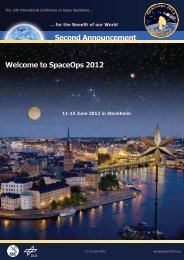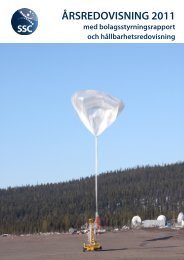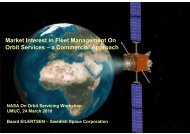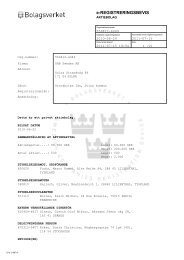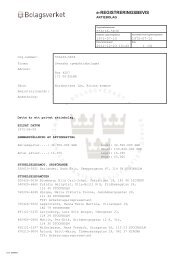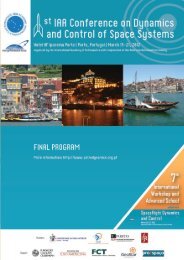Flight 188 - uppsagd
Flight 188 - uppsagd
Flight 188 - uppsagd
Create successful ePaper yourself
Turn your PDF publications into a flip-book with our unique Google optimized e-Paper software.
KOUROUMay 2009ARIANE 5Data relating to <strong>Flight</strong> <strong>188</strong> by Stéphane LEBOUCHERHERSCHELPLANCK
Data relating to <strong>Flight</strong> <strong>188</strong>1. Introduction<strong>Flight</strong> <strong>188</strong> is the 44 th Ariane 5 launch and the second in 2009. An ARIANE 5 ECA (CryogenicEvolution type A), the most powerful version in the ARIANE 5 range, will be used for this flight.<strong>Flight</strong> <strong>188</strong> is a scientific mission for Ariane 5. Launcher 546, the 40 th production phaseARIANE 5, is the eighteenth of the 30 PA contract launchers, for which ASTRIUM is productionprime contractor. 546 is consequently the nineteenth complete launcher to be delivered toArianespace, integrated and checked out under ASTRIUM responsibility in the LauncherIntegration Building (BIL).In a dual-payload configuration using the SYLDA 5 “F” (4.9m high) system and a long patternfairing (total height: 17m), the launcher is carrying the scientific satellites HERSCHEL in theupper position and PLANCK in the lower position.Installed inside the long pattern fairing built by:OERLIKON SPACEHERSCHEL built by prime contractor:THALES ALENIA SPACEStrapped to a type PAS 2624VS adaptor built by:SAABLocated inside the SYLDA 5 F built by:ASTRIUM STPLANCK built by prime contractor:Strapped to a type PAS 2624VS adaptor built by:ORBITAL Sciences Corp.SAABOperations in the Final Assembly Building (BAF) – where the satellites are integrated with thelauncher – and actual launch operations on the ARIANE 5 launch pad (ELA3) are coordinatedby Arianespace.3
Data relating to <strong>Flight</strong> <strong>188</strong>2. Launcher L546DescriptionThe upper composite is mounted on the main cryogenic stage (EPC) andincorporates:• Fairing• SYLDA 5 payload carrier structure,• The Upper Composite, which comprises:• ESC-A cryogenic upper stage,• Vehicle Equipment Bay• 3936 cone,The lower composite incorporates:• EPC (H175) main cryogenic stage with the new Vulcain 2 engine,• two identical EAP (P240) solid propellant strap-on boosters secured oneither side of the EPC.Type C main cryogenic stage:The EPC is over 30m high. It has a diameter of 5.4m and an empty mass ofonly 14.1 metric tons. It essentially comprises:• large aluminium alloy tank,• thrust frame transmitting engine thrust to the stage,• forward skirt connecting the EPC to the upper composite, and transmitting the thrustgenerated by the two solid propellant boosters.Liquid helium sub-system capacity© ASTRIUM ST4
Data relating to <strong>Flight</strong> <strong>188</strong>Compared with the ARIANE 5 “generic” version of the main stage, the main changes are integrationof the Vulcain 2 engine (generating 20% more thrust than the Vulcain 1), lowering of thetank common bulkhead, and strengthening of the forward skirt and thrust frame structures. Asin the case of the previous A5 ECA launcher (L521) used for flight 164, the Vulcain 2 has undergonea number of changes, principally to the nozzle (shortened and strengthened) and thecooling system (dump-cooling).The tank is divided into two compartments containing 175 tons propellant (approximately 25tons liquid hydrogen and 149.5 tons liquid oxygen). The Vulcain 2 engine delivers of the orderof 136 tons thrust, and is swivel-mounted (two axes) for attitude control by the GAM engineactuation unit. The main stage is ignited on the ground, so that its correct operation can bechecked before authorizing lift-off.The main stage burns continuously for about 535s, and delivers the essential part of the kineticenergy required to place the payloads into orbit.The main stage also provides a launcher roll control function during the powered flight phase bymeans of the SCR (roll control system).On burnout at an altitude of 213km for this mission, the stage separates from the upper compositeand falls back into the Atlantic Ocean.Type B solid propellant strap-on boosters:Each booster is over 31m high, and has a diameter of 3m and an empty mass of 38 tons. Eachbooster contains 240 tons solid propellant, and essentially comprises:• booster case assembled from seven cylindrical segments,• steerable nozzle (pressure ratio Σ = 11), operated by a nozzle actuation unit (GAT),• propellant in the form of three segments.Equipment displayed at Paris Air Show 2001The boosters (EAP) are ignited 6.05s after the Vulcain engine, i.e. 7.05s from H 0 . Booster thrustvaries in time (approx. 600 tons on lift-off or over 90% of total thrust, with a maximum of 650tons in flight. EAP burn time is about 140s, after which the boosters are separated from theEPC by cutting the pyrotechnic anchor bolts, and fall back into the ocean.5
Data relating to <strong>Flight</strong> <strong>188</strong>Compared with the ARIANE 5 “generic” version of the booster stage, the main changes includethe elimination of one GAT cylinder, overloading of segment S1 to increase thrust on lift-off, andthe use of a reduced mass nozzle (This reduces the mass of the structure by about 1.8tonnes.). This launch will use welded segment MPS solid rocket motors for the seventh time,following L534/flight 174, L536/flight 176, L537/flight 177, L538/flight 179 and L540/V183 andL545/V187.Type-A cryogenic upper stage:The ESC-A 3 rd stage has been developed for the ARIANE 5 ECA version of the ARIANE 5 Pluslauncher, and is based on the HM7B engine previously used for the 3 rd stage of the Ariane 4launcher.The ESC-A stage comprises:• two tanks containing 14.7 tons propellant (LH 2 and LOX),• HM7B engine delivering 6.5 tons thrust in vacuum for a burn time of about 925s. TheHM7B nozzle is swivel-mounted (two axes) for attitude control.To meet the needs of the mission, the ESC-A stage has a single helium sphere to cover thestage tank pressurisation and solenoid valve control requirements.The ESC-A and the SCAR systemThe ESC-A delivers the additional energy required to place the payloads into target orbit. Thisstage also provides a roll control function for the upper composite during the powered flightphase, and orients the payloads ready for separation during the ballistic phase using the SCAR(attitude and roll control system).6
Data relating to <strong>Flight</strong> <strong>188</strong>ESC-A thrust frame© EADS STAriane 5 ECA launcher in transit to launch pad ZL3 for thelaunch sequence rehearsal (RSL)© Ds23230ESA/ARIANESPACE/Service optique CSGType C vehicle equipment bay:The vehicle equipment bay (VEB) is a cylindrical carbon structure mounted on the ESC-Astage. The VEB contains part of the electrical equipment required for the mission (two OBCs,two new definition inertial guidance units, sequencing electronics, electrical power supplies,telemetry equipment, etc.).The upper composite (ESC-A stage + VEB + 3936 cone) for launcher L546 was assembledfor the eighth time at the Astrium ST site in Bremen, in order to meet needs resulting from theincrease in production rates for the coming years.Assembly of the upper composite at the Bremen site© EADS Astrium7
Data relating to <strong>Flight</strong> <strong>188</strong>Nose fairing:The ogival nose fairing protects the payloads during the atmospheric flight phase (acousticprotection on lift-off and during transonic flight, aerothermodynamic flux).A long pattern fairing is used for this mission. It has a height of 17m and a diameter of 5.4m.The fairing structure includes two half-fairings comprising 10 panels. These sandwich panelshave an expanded aluminium honeycomb core and two carbon fibre/resin skins.The fairing is separated from the launcher by two pyrotechnic devices, one horizontal (HSS)and the other vertical (VSS). The vertical device imparts the impulse required for lateralseparation of the two half-fairingsThe fairing has been coated with a new FAP (Fairing Acoustic Protection) product since flight175-L534.Fairing during integrationLauncher L545 fairing (in the BAF)© ESA/CNES/ARIANESPACE/Service optique CSG8
Data relating to <strong>Flight</strong> <strong>188</strong>SYLDA 5 (ARIANE 5 dual-launch system):This system provides for a second main payload inside one of the three fairing models. Thereare six different versions of this internal structure which has a diameter of 4.6m. SYLDA heightvaries between 4.6 and 6.4m (0.3m increments) for useful payload volumes between 50 and65m 3 .A SYLDA 5 ‘F’ with a height of 4.9m will be used for flight <strong>188</strong>.Sylda 5 No. 29-A for flight 183 during depreservation in the BAF in Kourou.© ASTRIUM ST9
Data relating to <strong>Flight</strong> <strong>188</strong>3. Mission V<strong>188</strong>Payload missionThe main mission of flight <strong>188</strong> is to place the HERSCHEL and PLANCK scientific payloads intopractically an escape orbit:Apogee altitude(with an apogee radiusPerigee altitude1,193,622 km1,200,000 km)270 kmInclination 6.0°Perigee argument 162°Ascending node longitude -108.0°(*)(*) in relation to a fixed axis, frozen at H 0 - 3s and passing through the ELA3 launch complex inKourou.The mass of HERSCHEL is 3,402 kg, with 1,921 kg for PLANCK.Allowing for the adaptors and the SYLDA 5 structure, total performance required from thelauncher for the orbit described above is 6,001 kg. Although total payload mass for this flight issubstantially less than the maximum capacity of the A5ECA launcher (of the order of 9,500 kgfor a standard GTO orbit inclined at 6°), the performance required from the launcher is veryclose to maximum performance level. This is due to the target orbit (practically an escape orbitto reach second Lagrange point L2).10
Data relating to <strong>Flight</strong> <strong>188</strong><strong>Flight</strong> phasesTaking H 0 as the basic time reference (1 s before the hydrogen valve of the EPC Vulcain enginecombustion chamber opens), Vulcain ignition occurs at H 0 + 2.7 s. Confirmation of nominalVulcain operation authorizes ignition of the two solid propellant boosters (EAP) at H 0 + 7.05 s,leading to launcher lift-off.Lift-off mass is about 771 tons, and initial thrust 13,100 kN (of which 90% is delivered by theEAPs).After a vertical ascent lasting 5s to enable the launcher to clear the ELA3 complex, includingthe lightning arrestor pylon in particular, the launcher executes a tilt operation in the trajectoryplane, followed by a roll operation 5 seconds later to position the plane of the EAPs perpendicularlyto the trajectory plane. The launch azimuth angle for this mission is 90° with respect toNorth.The EAP flight phase continues at zero angle of incidence throughout atmospheric flight, up toseparation of the boosters.The purpose of these operations is to:• optimize trajectory and thus maximize performance;• obtain a satisfactory radio link budget with the ground stations;• meet in-flight structural loading and attitude control constraints.The EAP separation sequence is initiated when an acceleration threshold is detected, whenthe solid propellant thrust level drops. Actual separation occurs within one second.11
Data relating to <strong>Flight</strong> <strong>188</strong>This is reference time H 1 , and occurs at about H 0 + 137.3s at an altitude of 67.3km and a relativevelocity of 2,021 m/s.For the remainder of the flight (EPC flight phase), the launcher follows an attitude law controlledin real time by the on-board computer, based on information received from the navigation unit.This law optimizes the trajectory by minimizing burn time and consequently consumption ofpropellant.The fairing is jettisoned during the EPC flight phase as soon as aerothermodynamic flux levelsare sufficiently low not to impact the upper (outer) payload. Separation of the fairing has beendelayed for this mission in view of the insolation constraints for the upper payload, and willoccur about 242.5 seconds after liftoff at an altitude of 146 km.The EPC powered flight phase is aimed at a predetermined orbit established in relation tosafety requirements, and the need to control the operation when the EPC falls back into theAtlantic Ocean.Shutdown of the Vulcain engine occurs when the following target orbit characteristics havebeen acquired:Apogee altitudePerigee altitude266.9 km-588.0 kmInclination 5.7°Perigee argument -84.3 °Ascending node longitude -106.9 °This is time reference H 2 . It happens at H 0 +534.7s.The main cryogenic stage (EPC) falls back into the Atlantic Ocean after separation (see below),breaking up at an altitude of between 80 and 60 km under the loads generated by atmosphericre-entry.The stage must be depressurized (passivated) to avoid any risk of explosion of the stage dueto overheating of residual hydrogen. A hydrogen tank lateral nozzle, actuated by a time delayrelay initiated on EPC separation, is used for this purpose.This lateral thrust is also used to spin the EPC, and thus limit breakup-induced debrisdispersion on re-entry.The main cryogenic stage angle of re-entry is -3.20°. The longitude of the point of impact is8.4°W.The subsequent ESC-A powered flight phase lasts a little over 15 minutes. This phase isterminated by a command signal from the OBC, when the computer estimates, from datacalculated by the inertial guidance unit, that the target orbit has been acquired.This is time reference H 3 . It happens at H 0 +1,469.9s.12
Data relating to <strong>Flight</strong> <strong>188</strong>The purpose of the following ballistic phase is to ensure:• Pointing of the upper composite in the direction required by HERSCHEL and PLANCKand then in that required for SYLDA 5,• triple-axis stabilization of the launcher before separation of HERSCHEL,• triple-axis stabilization of the launcher before separation of SYLDA 5,• slow spin-up at 6°/s before separation of PLANCK,• separation of HERSCHEL, SYLDA 5 and PLANCK,• final spin-up of the composite at 45°/s,• passivation of the ESC-A stage pressurized LOX tank and LH 2 tank, preceded by a prepassivationphase involving simultaneous opening of the eight SCAR nozzles.These operations contribute to short- and medium-term management of the mutual distancingof objects in orbit.The ballistic phase for the mission comprises 17 elementary phases described hereafter. Theseinclude separation of HERSCHEL (phase 2), SYLDA 5 separation (phase 4), and PLANCKseparation (phase 8).13
Data relating to <strong>Flight</strong> <strong>188</strong>14
Data relating to <strong>Flight</strong> <strong>188</strong>Staging of the various elements generated by the ballistic phase is described below.The launcher will be under telemetry monitoring by tracking stations in Kourou, Galliot, Natal,Ascension Island, Libreville and Malindi throughout the mission.With the performance necessary for this mission, the trajectory should include one period ofvisibility loss between Natal and Ascension (approx. 65s) (between Ascension and Libreville,recovery is approx. 5s).15
Data relating to <strong>Flight</strong> <strong>188</strong>The following plates show:• Situation of the main events of the flight,• Evolution of launcher altitude during powered flight.16
Data relating to <strong>Flight</strong> <strong>188</strong>4. PayloadsHERSCHEL and PLANCKThe two payloads are both ESA scientific satellites built under the prime contractorresponsibility of Thales Alenia Space France (Cannes).After separation from the launcher, the two satellites will move into their operationalorbits round the second Lagrange point (L2) about 1,500,000 km from the side of theEarth in shadow. This represents a little over four times the distance from Earth to theMoon. The satellites will take nearly 60 days to reach this virtual point in space, wherethey will be located in Lissajous orbits with an amplitude of 400,000 km round Lagrangepoint L2. Their distance from Earth will vary between 1.2 and 1.8 million km.17
Data relating to <strong>Flight</strong> <strong>188</strong>LAGRANGE pointsThe Lagrange points are points in space at which a body can remain fixed in relation totwo other bodies.Joseph-Louis Lagrange determined a five-point position for the Sun-Earth system, atwhich solar attraction and terrestrial attraction are precisely offset by the centrifugalforce induced by Earth's movement round the Sun. A satellite placed in orbit in relationto one of these points rotates round the Sun at the same speed as Earth, and is consequentlyfixed in relation to the two stars.By convention, the Lagrange points are denominated L1 to L5.Of the five Lagrange points, only L4 and L5 are stable. This means that matter tends toaccumulate at these points. The other points, such as L2, are consequently unstableand little perturbation is required for them to move out of position. It is for this reasonthat the two satellites will describe Lissajous orbits round L2 so as to minimise theirfuel consumption.The choice of point L2 is explained by the fact that the satellites will be protected fromthe Sun by Earth due to their alignment, thus providing excellent conditions for astronomicobservation purposes. Furthermore, in the case of Herschel, the instrumentscarried by the satellite will not be perturbed by the strong infrared emission from Earthand the Moon, nor will its observations be perturbed by the Earth's radiation belts. Asfor Planck, this satellite will thus avoid emission from Earth, the Moon and the Sun,such as could otherwise perturb the CMB (Cosmic Microwave Background) radiationsignal.18
Data relating to <strong>Flight</strong> <strong>188</strong>The HERSCHEL missionThis satellite is named after William Herschel who discovered and studied the thermaleffects of infrared radiation.The main task of the Herschel spacecraft is to study theformation and evolution of galaxies and stars. For thispurpose, the satellite will observe the cold and dusty zonesof the universe, zones opaque for other telescopes. TheHerschel telescope will also be used to observe gas anddust clouds in which stars and their surrounding disks areformed. Herschel will be the first spacecraft to cover thecomplete infrared range and the sub-millimetric wavelengths.Herschel is a Cassegrain type telescope and is the largestmirror telescope ever to be placed into orbit. Its main mirrorhas a diameter of 3.5 m, almost one and a half time that ofHubble (2.4 m) for a mass of only 300 kg (it comprisestwelve silicon carbide petals with a thickness of 3 mm, andwas built by ASTRIUM). Its secondary mirror has a diameterof 30 cm. The Herschel spacecraft is 7.5 m long and hasa lift-off mass of 3,402 kg. Once in its final orbit, it will bestabilised (triple-axis) and its orientation will depend on itsobservation programme.19
Data relating to <strong>Flight</strong> <strong>188</strong>Herschel carries the following instruments:• the HIFI (Heterodyne Instrument for the Far Infrared) whichwill make it possible to observe a single point in the sky.This instrument incorporates seven heterodyne receiversand a very high spectral resolution spectrometer operatingin the 157-610 μm band;• the PACS (Photoconductor Array Cameraand Spectrometer) is a blue and redfocal plane photo-detector and widebandspectrometer covering the 60-120 μmand 120-210 μm bands;• the SPIRE (Spectral and Photometric Imaging REciever)will be able to observe a vast region of the sky at the sametime. SPIRE is an infrared camera coupled with a Fouriertransform spectrometer comprising a set of bolometers operatingin the 200-670 μm band.These three instruments are housed in the cryostat and maintained at low temperature(< 1.7°K) by suprafluid helium (LHeII) in the HTT (Helium Two Tank). The operationallifetime of the cryostat depends directly on the LHeII supply autonomy of the satellite,for which the minimum anticipated is 3 years.20
Data relating to <strong>Flight</strong> <strong>188</strong>Typical application:The Andromeda galaxy, situated at 2 .5 millions lightyears from Earth, is one of the closest to our owngalaxy. Andromeda represents a good example ofthe possibilities for space exploration in the IR domain,and is regarded as a typical spiral galaxy.Observation in the IR domain using ESA resourcesdemonstrates that the galaxy comprises a number ofconcentric dust rings at a temperature of close to10/12°K, substantially colder than earlier predictions.Conventional telescopes cannot detect these phenomena,and the Andromeda rings are still largelyterra incognita. Only observations made by Herschelwill enable us to obtain comprehensive knowledgeof the constitution of this type of galaxy.21
Data relating to <strong>Flight</strong> <strong>188</strong>The PLANCK missionThe Planck satellite has been designed to analyse andmeasure, with unequalled precision, the very low temperaturevariations, or “anisotropies”, of the of the firstlight which filled the Universe after the Big Bang, namelyCosmic Microwave Background (CMB) radiation. Planckwill cover the whole sky with an angular resolution of 5minutes of arc, improving by a factor of about 15 on theinformation delivered by its predecessor WMAP. With the data collected by Planck, thescientists hope to obtain a better understanding of the origin, evolution and geometryof the Universe, and the nature of black energy and the minute matter density fluctuationsat the origin of the galaxies.1 billion years afterthe Big Bang: thegalaxies300,000 yearsafter the BigBang: CMBemission5.5 billion years after theBig Bang: Earth1 s to 3 mn afterthe Big BangPlanck is taking over from the COBE and WMAP satellites (launched by NASA in 1992and 2003 respectively) and will provide very substantially enhanced measurementprecision.Sky maps as seen by COBE: the first image presentsthe temperature of the sky: we observe theimpact of movement of the Sun (dipole form) andthe Milky Way (weak horizontal smudge).With these two effects eliminated, the seconddiagram presents a wideband associated with theresidual emission of the galaxy, and a backgroundfilled with hot and cold points due largely to mixtureof the CMB with the measurement noiseinduced by the instrument.22
Data relating to <strong>Flight</strong> <strong>188</strong>Sky map as seen by WMAP: this image presents a marked enhancement of the clarityand acuity of the sky map resulting from WMAP resolution. It shows minuscule CMBtemperature irregularities.The rotational speed of the satellite, separatedunder slow spin, will stabilise at 1 rotation perminute, making it possible to scan the entire skyin 6 months. Planck will acquire data coveringfour to five times the complete Universe in thespace of 21 months.The 1.5 m-diameter Planck telescope will focus radiation ontwo instruments:• The HFI (High Frequency Instrument) comprises 50bolometers and will be used to convert radiation (from awavelength of 1 cm to 1/3 mm) into heat. The focal planeof this instrument operates at a temperature of 0.1°K;• The LFI (Low Frequency Instrument) comprises a numberof radio receivers operating at a temperature of -253°C.The two instruments will be kept permanently chilled by acooling system operating in the cascade mode (passive systemto 50°K, Sorption Cooler to 18°K, 4°K Cooler to 4°K andDilution Cooler to 0.1°K).23
Data relating to <strong>Flight</strong> <strong>188</strong>5. Launch campaignAriane 5 ESC-A flight thrust frame at EADS-STLes Mureaux, before departure for Astrium inBremen© EADS ST photo: Studio BernotThe Ariane 5 main cryogenic stage (EPC) in theintegration dock at Les Mureaux, France, incourse of preparation for tilt andcontainerization© EADS ST photo: Studio BernotThe main cryogenic stageloading on board the"Toucan" in the port of LeHavre for shipment toFrench Guiana© EADS ST photo: JL24
Data relating to <strong>Flight</strong> <strong>188</strong>Principal phases of the flight 187 launch campaign:Arrival of HERSCHEL in French Guiana January 29, 09EPC depreservation and erection in the launcher integration building(BIL)February 5, 09Transfer of Solid Booster Stages (EAP) February 5 & 6, 09Mating of the EAPs with the EPC February 9, 09Depreservation and erection of the Upper Composite February 11 & 14, 09V187: Success of the HOTBIRD TM 10/NSS-9/SPIRALE mission onlauncher L545February 12, 09Assembly of the ARF on the ESC-A February 16, 09Arrival of PLANCK in French Guiana February 18, 09Launcher Synthesis Control March 2, 09Launcher acceptance by Arianespace March 6, 09Transfer from BIL to BAF March 9, 09Launcher mothballing March 10, 09Launcher recovery April 16, 09Assembly of HERSCHEL on its adaptorHERSCHEL fuelling with hydrazineCryostat fuelling with LHeTransfer to the BAFAssembly on the SYLDA 5Assembly of PLANCK on its adaptorPLANCK fuelling with hydrazineTransfer to the BAFS/C integration on the launcherSYLDA integration on the launcherLaunch Rehearsal May 7, 09<strong>Flight</strong> Readiness Review (Part I) May 9, 09Final preparation of HERSCHELFairing integration on the launcher<strong>Flight</strong> Readiness Review (Part II)Arming of the launcherLauncher transfer from the BAF to the Pad (ZL3)Fuelling of the EPC helium sphereMarch 27, 09April 9, 09Bet. April 10 & 28, 09April 29, 09April 30, 09April 11, 09April 15 & 16, 09April 22, 09April 23, 09April 27, 09May 10, 09May 12, 09May 13, 09Final countdown May 14, 09Kourou: depreservation and erection ofthe EPC in the BIL© ESA/ARIANESPACE/Service optique CSG25
Data relating to <strong>Flight</strong> <strong>188</strong>Kourou: transfer of the launcher L545 from the Launcher Integration Building (BIL) to the Final Assembly Building© ESA/ARIANESPACE/Service optique CSGKourou: erection of the Upper Composite inthe Launcher Integration Building (BIL)© ESA/ARIANESPACE/Service optique CSGKourou: transfer from the Final Assembly Building(BAF) to the pad for the Launch Sequence Rehearsal(RSL)© ESA/ARIANESPACE/Service optique CSG26
Data relating to <strong>Flight</strong> <strong>188</strong>6. Launch windowThe window for a launch on May 14, 2009, with H 0 at 01.12 p.m. (UT) is at 02.07 p.m. (UT).The launch window will last 55 minutes:Paris and The Hague timeMay 14, 200903.12 p.m. – 04.07 p.m.KOUROU timeMay 14, 200910.12 a.m. – 11.07 a.m.UNIVERSAL TIMEMay 14, 200901.12 p.m. – 02.07 p.m.The launch window for this mission is dictated principally by satellite-related constraints (associatedwith the manoeuvring capabilities of the satellites, and an absence-of-insolation constraintfor Herschel).The window will vary as follows in the event of a launch postponement:- 15 May between 01.12 p.m. (TU) and 02.08 p.m. (56 minutes),- 16 May between 01.13 p.m. (TU) and 02.08 p.m. (55 minutes),- 17 May between 01.14 p.m. (TU) and 02.08 p.m. (54 minutes),- 18 May between 01.14 p.m. (TU) and 02.08 p.m. (54 minutes).27
Data relating to <strong>Flight</strong> <strong>188</strong>7. Final countdownThe final countdown includes all operations for preparation of the launcher, satellites andlaunch base. Correct execution of these operations authorizes ignition of the Vulcain engine,followed by the solid propellant boosters at the selected launch time, as early as possible insidethe launch window for the satellites. The countdown terminates with a synchronized sequencemanaged by the Ariane ground checkout computers, starting at H 0 - 7 min. In some cases, apre-synchronized sequence may be necessary to optimize fuelling of the main cryogenic stage(*). If a countdown hold pushes time H 0 outside the launch window, the launch is postponed toD+1 or D+2, depending on the nature of the problem and the solution adopted.H0 - 7 hours 30H0 - 6 hoursH0 - 5 hoursH0 - 5 hoursH0 - 4 hoursH0 - 3 hoursH0 - 30 minutesCheckout of electrical systems.Flushing and configuration of the EPC and Vulcain engine for fuellingand chill-downFinal preparation of the launch pad: closure of doors, removal of safetybarriers, configuration of the fluid circuits for fuelling.Loading of the flight programTesting of radio links between the launcher and BLAAlignment of inertial guidance unitsEvacuation of personnel from the launch padFuelling of the EPC in four phases:pressurization of the ground tanks (30 minutes)chill-down of the ground lines (30 minutes)fuelling of the stage tanks (2 hours)topping up (up to synchronized sequence)Pressurization of the attitude control and command systems:(GAT for the EAPs and GAM for the EPC)Fuelling of the ESC-A stage in four phases:pressurization of the ground tanks (30 minutes)chill-down of the ground lines (30 minutes)fuelling of the stage tanks (1 hour)topping up (up to synchronized sequence)Chill-down of the Vulcain enginePreparation of the synchronized sequenceH0 - 7 minutes Beginning of the synchronized sequence (*)(*) The standard synchronised sequence will start at T 0 - 7 minutes, incorporating all finallauncher operations leading to lift-off. By comparison, the stretched synchronised sequence forflight 173 commenced at T 0 - 12 minutes, to cater for top-up LOX fuelling of the EPC stage tomeet mission performance requirements.28
Data relating to <strong>Flight</strong> <strong>188</strong>Synchronized sequenceThese operations are controlled exclusively and automatically by the ELA3 operationalcheckout-command (CCO) computer. During this sequence, all the elements involved in thelaunch are synchronized by the “countdown time” distributed by the CSG.During the initial phase (up to H 0 - 6s), the launcher is gradually switched to its flightconfiguration by the CCO computer. If the synchronized sequence is placed on hold, thelauncher is returned automatically to its configuration at H 0 - 7 min.In the second, irreversible phase of the sequence (H 0 - 6 s to H 0 - 3.2 s), the synchronizedsequence is no longer dependent on CGS countdown time, and operates on an internal clock.The final phase is the launcher ignition phase. The ignition sequence is controlled directly bythe on-board computer (OBC). The ground systems execute a number of actions in parallel withthe OB ignition sequence.29
Data relating to <strong>Flight</strong> <strong>188</strong>FLUID SYSTEMSH 0 - 6 min 30sTermination of topping up (LOX and LH 2 )LOX and LH 2 topped up to flight valueLaunch pad safety flood valves openedELECTRICAL SYSTEMSH 0 - 6 min 30sArming of pyrotechnic line safety barriersH 0 - 6 min: Isolation of the ESC-A helium sphereH 0 - 4 min<strong>Flight</strong> pressurization of EPC tanksIsolation of tanks and start of EPC ground/OBinterface umbilical circuit flushingTermination of ESC-A LOX topping upESC-A LOX transition to flight pressureH 0 - 3 min 40: termination of ESC-A LH2 topping upH 0 - 3 min10: ESC-A LH 2 transition to flight pressureH 0 - 2 min: Vulcain bleeder valves openedEngine ground chill-down valve closedH 0 - 1min 5sTermination of ESC-A tank pressurization from theground, and start of ESC-A valve plate sealtightnesscheckoutH 0 - 30sVerification of ground/OB umbilical circuitflushingEPC flue flood valves openedH 0 - 16.5 sPressurization of POGO corrector systemVentilation of fairing POP and VEB POEconnectors and EPC shut downH 0 - 3 min 30 : Calculation of ground H 0 andverification that the second OBC has switched tothe observer modeH 0 - 3 minH 0 loaded in the 2 OBCsH 0 loaded in OBCs checked against ground H 0H 0 - 2 min 30s: Electrical heating of EPC and VEBbatteries, and electrical heating of the Vulcain 2ignition system shut downH 0 - 1 min 50sPre-deflection of the HM7B nozzleH 0 - 1min 5sLauncher electrical power supply switched fromground to OBH 0 - 37sStart-up of ignition sequence automatic controlsystemStart-up of OB measurement recordersArming of pyrotechnic line electric safety barriersH 0 - 22sActivation of launcher lower stage attitude controlsystemsAuthorization for switchover to OBC controlH 0 - 12 s Flood valves opening command30
Data relating to <strong>Flight</strong> <strong>188</strong>IRREVERSIBLE SEQUENCEH 0 - 6sArming and ignition of AMEFs to burn hydrogen run-off during chill-down of the combustionchamber on Vulcain ignitionValve plate and cryogenic arm retraction commandsH 0 - 5.5sGround information communication bus control switched to OBCIGNITION SEQUENCEH 0 - 3sCheckout of computer statusSwitchover of inertial guidance systems to flight modeHelium pressurization activatedLOX and LH 2 pressures monitoredNavigation, guidance and attitude control functions activatedH 0 - 2.5sVerification of HM7B nozzle deflectionH 0 - 1.4sEngine flushing valve closedH 0 - 0.2sVerification of acquisition of the “cryogenic arms retracted” report by the OBC at the latestmomentH 0 → H 0 + 6.65sVulcain engine ignition and verification of its correct operation(H 0 +1s corresponds to opening of the hydrogen chamber valve)H 0 + 6.9sEnd of Vulcain engine checkoutH 0 + 7,05sIgnition of the EAPs31
Data relating to <strong>Flight</strong> <strong>188</strong>8. <strong>Flight</strong> sequencetime /H 0(s)time/H 0(mn)eventaltitude(km)mass(kg)Vreal(m/s)- - - - EAP-EPC powered flight - - -7.31 0 ’ 07 ’’ Lift-off --- 771.1 012.41 0 ’ 12 ’’ Start of tilt manoeuvre 0.09 744.3 37.217.05 0 ’ 17 ’’ Start of roll manoeuvre 0.35 719.0 78.632.05 0 ’ 32 ’’ End of roll manoeuvre 2.6 639.7 224.546.5 0 ’ 47 ’’ Transsonic (Mach = 1) 6.4 581.4 323.464.5 1 ’ 05 ’’ Pdyn max. 12.7 509.1 497.6110.3 1 ’ 50 ’’137.3 2 ’ 17 ’’Transition to γ max(42.54 m/s 2 )Transition to γ = 6.22 m/s²H 141.1 303.4 1,596.167.3 249.9 2,020.9138.1 2 ’ 18 ’’ EAP separation 68.0 175.9 2,022.3- - - - EPC powered flight - - - -242.5 4 ’ 02 ’’ Fairing jettisoned 146.0 138.9 2,540.4315 5 ’ 15 ’’ Intermediate point 181.7 116.8 3,101.3408 6 ’ 48 ’’ Acquisition Natal 214.8 84.5 4,340.1470 7 ’ 50 ’’ Culmination 221.5 65.0 5,422.0534.7 8 ’ 55 ’’ EPC burnout (H 2 ) 214.3 44.4 7,031.7540.7 9 ’ 01 ’’ EPC separation 212.8 25.1 7,062.0- - - - ESC-A powered flight - - - -544.9 9 ’ 05 ’’ ESC-A ignition 211.7 25.1 7,066.0640 10 ’ 40 ’’ Intermediate point 186.2 23.6 7,355.9740 12 ’ 20 ’’ Lost Natal 168.0 22.3 7,628.9806 13 ’ 26 ’’ Acquisition Ascension 158.9 21.2 7,862.4860 14 ’ 20 ’’ Resource (minimum altitude) 157.2 20.5 8,004.11,071 17 ’ 51’’ Acquisition Libreville 208.5 17.4 8,687.21,075 17 ’ 55 ’’ Lost Ascension 210.7 17.3 8,703.41,200 20 ’ 00 ’’ Intermediate point 316.2 15.4 9,096.11,330 22 ’ 10 ’’ Acquisition Malindi 521.9 13.4 9,520.81,470 24 ’ 30 ’’ ESC-A burnout (H 3-1 ) 847.6 11.3 9,96832
Data relating to <strong>Flight</strong> <strong>188</strong>time /H 0 time/H 0altitudeevent(s) (mn)(km- - - - “Ballistic” phase - - -1,472 24 ’ 32 ’’ Phase 1 Adjustment manoeuvres at start of SCAR phase 8541,558 25 ’ 58 ’’ HERSCHEL separation (H 4.1 ) 1,1331,568 26 ’ 08 ’’ Phase 3 Start of SYLDA orientation 1,1671,644 27 ’ 24 ’’ SYLDA separation (H 4.2 ) 1,4491,654 27 ’ 34 ’’ Phases 5 Start of PLANCK orientation 1,4881,677 27 ’ 57 ’’ Phases 6 Slow spin-up at 5°/s for PLANCK (CA 5) 1,5781,705 28 ‘ 25’’ Phases 7 Slow spin-up at 6°/s for PLANCK (CA 1) 1,6931,708 28 ’ 28 ’’ PLANCK separation (H 4.3 ) 1,7101,718 28’ 38 ’’ Phase 9 Composite despin 1,7511,730 28 ’ 50 ’’ Phase 10 to 15 ESC-A orientation for the final spin-up 1,8022,487 41 ’ 27 ’’ Phases 16 Start of spin-up at 45°/s 5,6042,586 43 ’ 06 ’’ Phase 17 Start of ESC-A pre-passivation 6,1402,614 43 ’ 34 ’’ Oxygen tank passivation (breakdown S34) 6,2892,887 48 ’ 07 ’’ ESC-A passivation (breakdown S37) 7,771Note: This provisional flight sequence is coherent with the stage propulsion laws available atthe time of drafting this document.33
Data relating to <strong>Flight</strong> <strong>188</strong>9. EADS ASTRIUM and the ARIANE programmesAstrium Space Transportation, a business unit of EADS Astrium, is the European specialistfor access to space and manned space activities. It develops and produces Ariane launchers,the Columbus laboratory and the ATV cargo carrier for the International Space Station,atmospheric re-entry vehicles, missile systems for France's deterrent force, propulsion systemsand space equipment.EADS Astrium, a wholly owned subsidiary of EADS, is dedicated to providing civil and defencespace systems. In 2008, EADS Astrium had a turnover of €4.3 billion and 15,000 employees inFrance, Germany, the United Kingdom, Spain and the Netherlands. Its three main areas ofactivity are Astrium Space Transportation for launchers and orbital infrastructure, andAstrium Satellites for spacecraft and ground segment, and its wholly owned subsidiaryAstrium Services for the development and delivery of satellites in orbit.EADS is a global leader in aerospace, defence and related services. In 2008, EADS generatedrevenues of €43.3 billion and employed a workforce of more than 118, 000.EADS Astrium has acquired extensive expertise, unrivaled in Europe, as industrial architect orprime contractor for large-scale strategic and space programs. This position is based on thecompany's ability to direct and coordinate the wealth of expertise required to design anddevelop complex projects.In line with the ESA resolution concerning restructuring of the Ariane launcher system, involvinga redistribution of responsibilities between the various players involved in design, developmentand manufacture, Ariane program activities in the industrial domain are now structured round asingle prime contractor (see European Space Agency Council Meeting at Ministerial level ofMay 27, 2003)As from the current ARIANE 5 production batch (PA batch), Astrium Space Transportation isconsequently sole prime contractor for the Ariane 5 system. In this context, the company isresponsible for supplying Arianespace with complete, tested launchers, and for managing allcontracts necessary for launcher production. Astrium ST also supplies all component elementsfor ARIANE 5, including the stages built in its Les Mureaux (France), Bremen (Germany) andKourou (French Guiana) facilities, the Vehicle Equipment Bay, the flight program and numeroussub-assemblies.EADS Astrium is now the sole point of contact for the European Space Agency for futurelauncher development, acting as sole prime contractor in this domain also.EADS Astrium possesses the multidisciplinary expertise required to control a program of thiscomplexity:• program management: risk, configuration, dependability and documentation management,• technical management: approval of the definition and qualification of launcher elements,overall coherence control and interface management,• system engineering: integrated system (aerodynamic, acoustic, thermal, structural, flightmechanics, guidance and attitude control and POGO correction) studies, and testing(acoustic, thermal, dynamic and electrical models),• flight programs: design, qualification and development of flight programs, each specific to aparticular mission,• customer assistance: the company plays a major role in Ariane launch campaigns, providingsupport for Arianespace throughout launch operations,• mission analysis and flight data analysis after each launch.34
Data relating to <strong>Flight</strong> <strong>188</strong>EADS Astrium is prime contractor for all Ariane 5 launcher stages - the main cryogenic stage(EPC), solid propellant boosters (EAP) and the various versions of the upper stage.The EPC is integrated in the company's vast Les Mureaux complex near Paris. This site islocated close to Cryospace, an EADS SPACE Transportation/AIR LIQUIDE joint venture whichmanufactures the main stage propellant tanks. Also nearby is the functional simulation facilitywhere Astrium developed the launcher's electrical system and software, as well as itsguidance-attitude control and navigation system.To ensure maximum safety, the solid propellant boosters are manufactured in French Guiana.Astrium integrates the booster stages in dedicated buildings at the Guiana Space Center(CSG) with the MPS solid propellant motor supplied by Europropulsion, adding electrical,pyrotechnic, hydraulic, parachute recovery and other elements supplied from Europe. This isthe first time that a major part of the launcher has been constructed in French Guiana. Acomplete Ariane 5 "assembly line" and launch system was built up in French Guiana between1988 and 1996, including not only production facilities for the solid propellant boosters, but alsoassembly buildings for launcher elements shipped out from Europe and all payload preparationfacilities.The different versions of the Ariane 5 upper stage are manufactured at the Astrium Bremensite in North Germany. Up to five upper stages can now be assembled simultaneously. Thecompany's other German sites at Ottobrunn near Munich, and Lampoldshausen, supply thecombustion chambers for the Ariane 5 Vulcain main engine, and the Aestus motor for the basicversions of the upper stage.EADS Astrium is also responsible for the SYLDA 5 (SYstème de Lancement Double Ariane 5)built in its Les Mureaux (France).EPC Integration Site in Les Mureaux(F )Site internet EADS Astrium : www.astrium.eads.netSite internet ARIANESPACE : www.arianespace.com35



